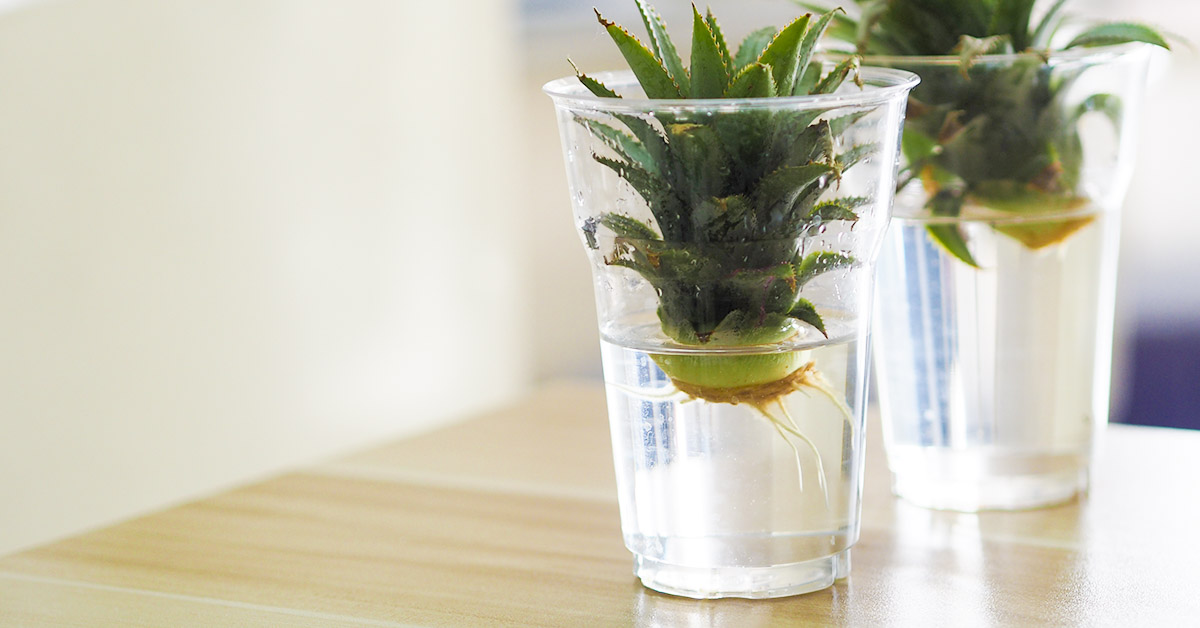The next time you’re cutting into a pineapple, don’t toss the spiky top. Instead, turn it into a houseplant that can eventually grow you another pineapple. You don’t need a tropical climate for this project, just plenty of space and bright light. If you don’t have much experience growing fruit, don’t worry. These plants are simple to maintain, with guidelines similar to succulent care. It can take a long time to grow a new pineapple but the sweet flavor and freshness of the fruit makes it worth the wait. Plus, you get to enjoy a beautiful and unique houseplant until it’s time to harvest.
How to Grow a Pineapple Houseplant In 4 Steps

1. Choose the pineapple
Begin by carefully choosing your pineapple since some propagate more easily than others. Look for one with green leaves and some new ones forming. The leaves should be healthy-looking, although a few dead ones or brown tips are okay. Avoid fruits with bugs. Keep in mind the tops good for propagating may not be attached to pineapples you’d want to eat. You generally want the fruit to look ripe and very yellow, which gives the leaves more time to decay. It might take some time to find a pineapple that fits both needs.
Twist off the spiky top of the pineapple and ensure there’s no fruit on it. Remove some of the lower leaves to expose the stem and the root buds around it. Now, set the stem aside for a few days until the cut part dries out. This will help prevent rot after you plant it. [1]
Read: 10 Tips for Growing Avocado in a Pot and for it to bear fruit
2. Plant the stem in water or soil
Next, there are two common methods of planting the stem, and one involves a simple cup of water. Place the pineapple stem into the cup in a warm and bright area with indirect sunlight for about three weeks. Use a clear glass so you can see the plant develop, and change the water every few days. When the roots grow to about two or three inches long with no signs of fungus or rot, the pineapple top is ready for the next step. Remember, all attempts may not work out so be prepared to buy multiple fruits.
Find a 5-gallon container with holes for good drainage and fill it with a mix of sand, perlite, and potting soil. You can also use cactus soil. Place the stem into the soil, making sure the lowest leaves are still visible. You may need to press the soil around the stem to keep the top standing straight. If possible, keep the container in a sunny area with indirect light and humidity. If your house is typically dry, you might want to keep it in a bathroom. Or you can use a pebble tray with other plants to make a rainforest effect. Or you can resort to a humidifier. Then, slowly acclimate the plant to full sunlight. Water the plant when the soil feels dry, but never let it become soggy. Overall, these plants handle under-watering better than over-watering. In the warmer seasons, apply a water-soluble fertilizer once a month.
Alternatively, you can plant the spiky top of the pineapple directly into the soil while skipping the water cup step, but this method prevents you from monitoring the roots as they grow. However, if you choose this route, skip the water step and plant the stem into the soil as previously described.
3. Grow the pineapple outside
During late spring and summer, you can bring the pineapple houseplant outside. Place it in an area with filtered shade where it can catch rainwater and enjoy the humidity. Be careful not to overwater this plant since it can cause root rot. Instead, check the soil for dryness before adding water to it. Remember to bring the pineapple back inside before the frost comes. Temperatures colder than 60 degrees Fahrenheit can slow its growth, but freezing temperatures can damage it. If you notice pests like mealybugs and scale infesting your growing pineapple plant, treat the plant with neem oil or another non-toxic horticultural oil until the bugs disappear. [2]
4. Harvest the pineapple
This pineapple houseplant will grow one fruit and it could take some time to appear. For instance, the plant may only bloom after two years and the fruit won’t begin growing until a few months after that. You will see the tiny pineapple emerging from the leaves. Wait until it turns golden brown and smells ripe before harvesting it with a knife. Unfortunately, the original plant will slowly die after the harvest but you can repeat the process with your new home-grown pineapple. [3]
Keep Reading: There’s a scientific reason why fresh pineapple makes some people’s mouths bleed
Sources
- “Growing a pineapple from the top | In 4 easy steps.” Houseplant Central. Marijke Puts. October 9, 2023
- “How to Regrow Pineapple from Kitchen Scraps.” Gardener’s Path. Gretchen Heber. February 28, 2018
- “How to Plant and Grow Pineapple.” Better Homes Gardens.Lynn Coulter and Lynn AcAlphine. July 5, 2023.

